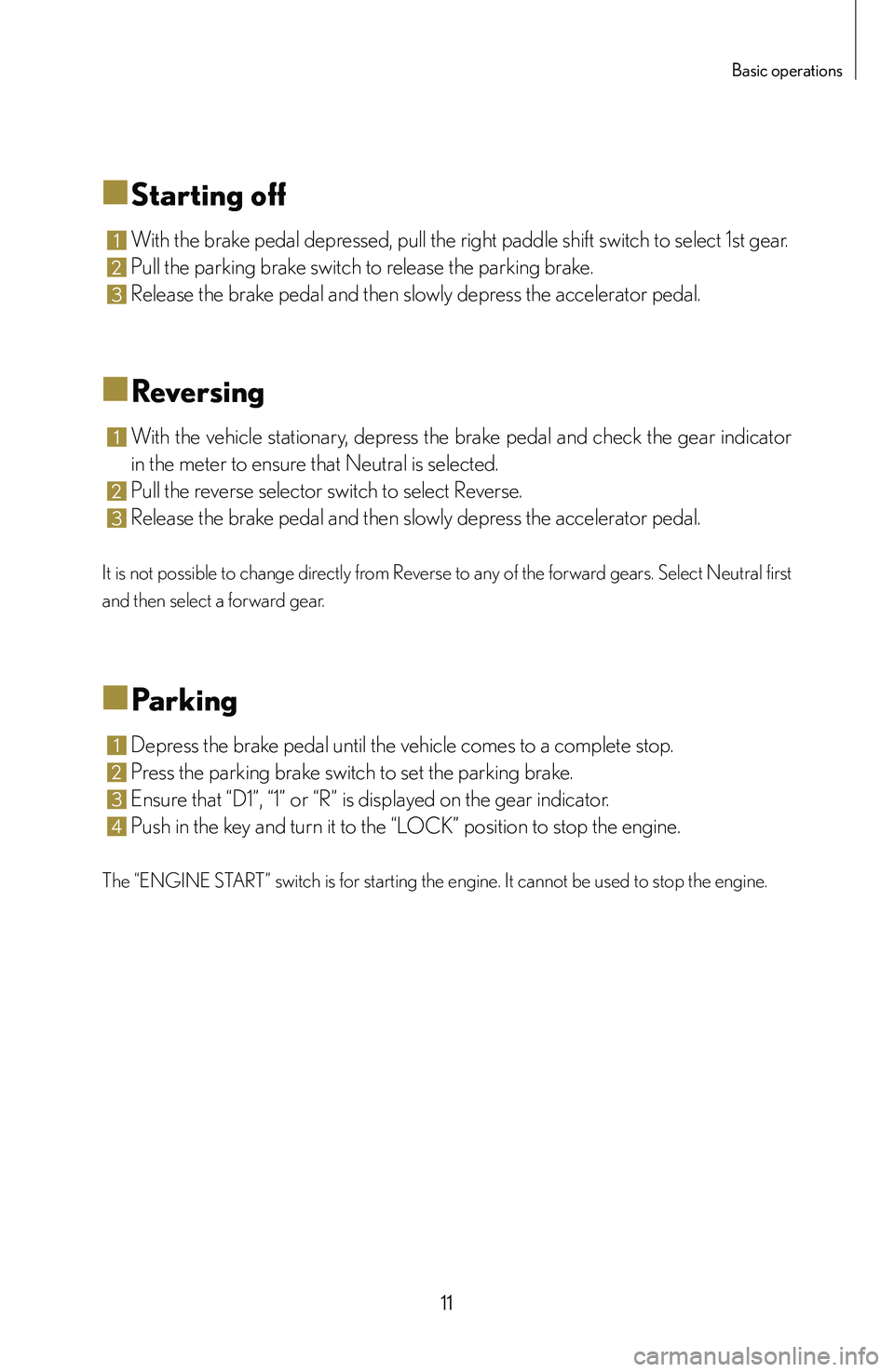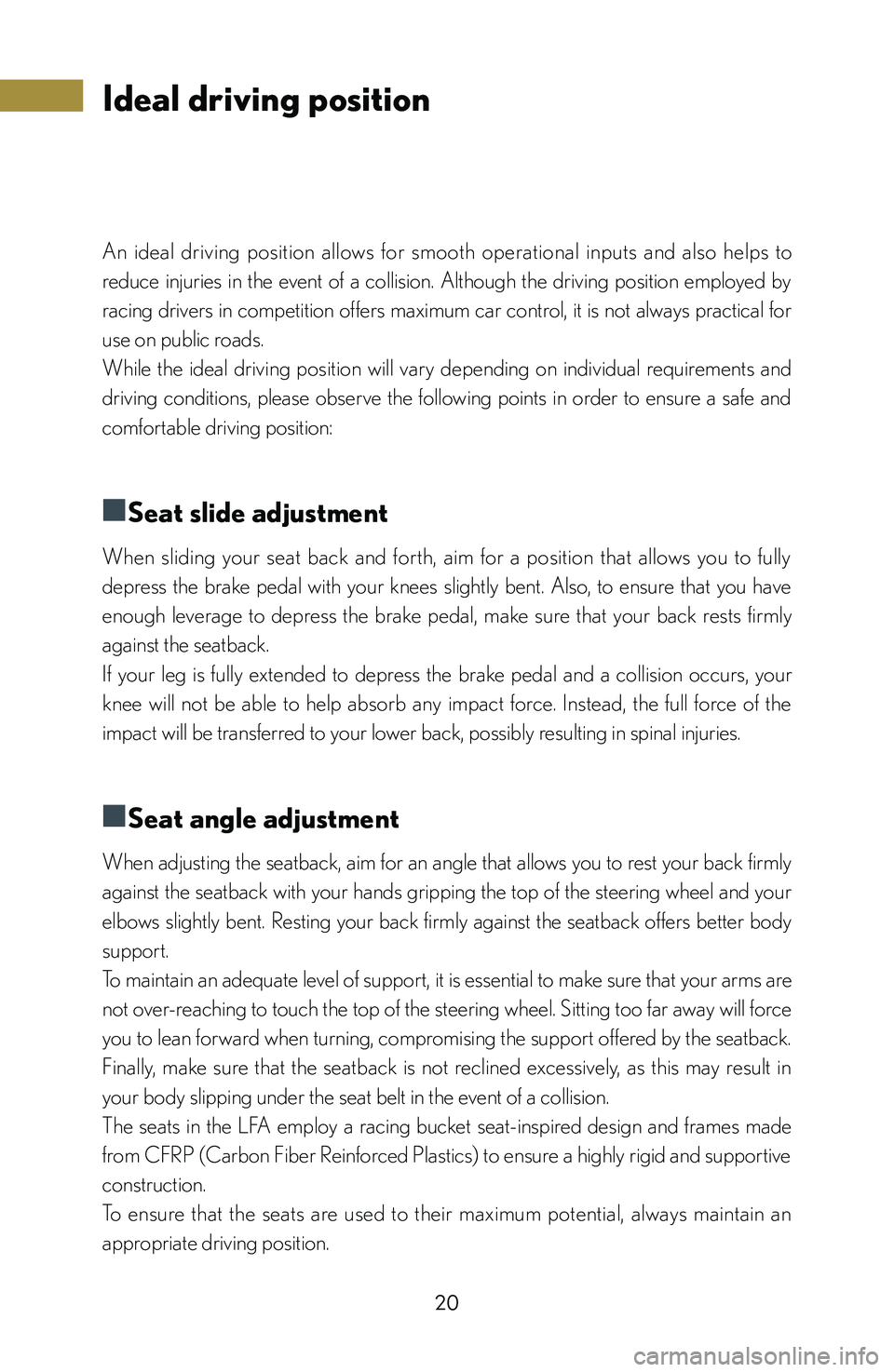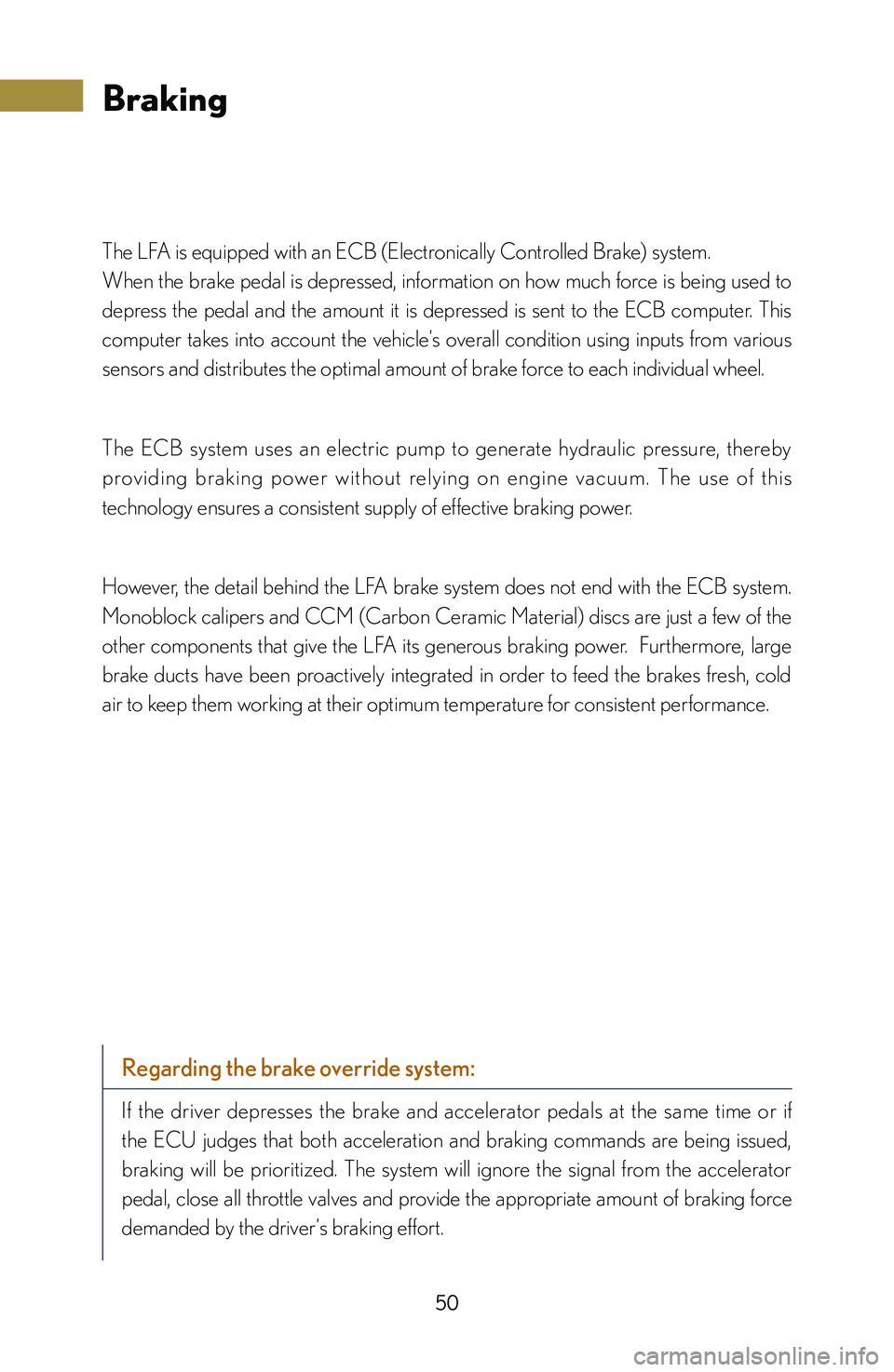2012 Lexus LFA brake
[x] Cancel search: brakePage 11 of 128

9
Basic operations
1 Reverse selector switch
Pull the switch to select Reverse (R).
2 Paddle shift switches ("P. 40)
Pull the right paddle shift switch to upshift and the left paddle shift switch to
downshift. Pull both paddle shift switches at once to select Neutral (N).
3 Control pad ("P. 66)
4 “ENGINE START” switch
5 Driving mode selector switch ("P. 26)
6 AUTO driving mode button ("P. 27)
7 Shift speed selector ("P. 41)
Allows the driver to choose their desired shift speeds for the manually shifted
SPORT, NORMAL, and WET driving modes.
8 Parking brake switch
9 Ignition switch
10 Accelerator pedal ("P. 32)
11 Tilt and telescopic steering lock release lever
12 Brake pedal ("P. 50)
13 Hood release lever ("P. 12)
14 Rear hatch opener switch ("P. 12)
15 Fuel filler door opener switch ("P. 12)
16 Outside rear view mirror switches
17 VSC off switch
Turns VSC and TRAC off. Press the switch again to turn VSC and TRAC back on.
Page 12 of 128

10
■
■Driving position adjustment
1 Insert the key into the ignition switch
and then turn the key to the “ACC”
position.
2 Use the seat adjustment switches (A)
to move the driver seat. You should
be able to fully depress the brake
pedal with your knees slightly bent.
3 Adjust the height of the seat and the
position of the steering wheel. You
should be able to grip the top of the steering wheel with your elbows slightly bent
and your back at a comfortable angle.
4 If necessary, readjust the seat position.
5 Adjust the mirrors to ensure that you have a good view of the area behind the
vehicle.
■
■Starting the engine
1 With the brake pedal depressed, turn the key to the “ON” position.
2 Pull both paddle shift switches at the same time to select Neutral.
3 Press the “ENGINE START” switch to start the engine.
(A)
Page 13 of 128

11
Basic operations
■
■Starting off
1 With the brake pedal depressed, pull the right paddle shift switch to select 1st gear.
2 Pull the parking brake switch to release the parking brake.
3 Release the brake pedal and then slowly depress the accelerator pedal.
■
■Reversing
1 With the vehicle stationary, depress the brake pedal and check the gear indicator
in the meter to ensure that Neutral is selected.
2 Pull the reverse selector switch to select Reverse.
3 Release the brake pedal and then slowly depress the accelerator pedal.
It is not possible to change directly from Reverse to any of the forward gears. Select Neutral first
and then select a forward gear.
■
■Parking
1 Depress the brake pedal until the vehicle comes to a complete stop.
2 Press the parking brake switch to set the parking brake.
3 Ensure that “D1”, “1” or “R” is displayed on the gear indicator.
4 Push in the key and turn it to the “LOCK” position to stop the engine.
The “ENGINE START” switch is for starting the engine. It cannot be used to stop the engine.
Page 22 of 128

20
Ideal driving position
An ideal driving position allows for smooth operational inputs and also helps to
reduce injuries in the event of a collision. Although the driving position employed by
racing drivers in competition offers maximum car control, it is not always practical for
use on public roads.
While the ideal driving position will vary depending on individual requirements and
driving conditions, please observe the following points in order to ensure a safe and
comfortable driving position:
■
■Seat slide adjustment
When sliding your seat back and forth, aim for a position that allows you to fully
depress the brake pedal with your knees slightly bent. Also, to ensure that you have
enough leverage to depress the brake pedal, make sure that your back rests firmly
against the seatback.
If your leg is fully extended to depress the brake pedal and a collision occurs, your
knee will not be able to help absorb any impact force. Instead, the full force of the
impact will be transferred to your lower back, possibly resulting in spinal injuries.
■
■Seat angle adjustment
When adjusting the seatback, aim for an angle that allows you to rest your back firmly
against the seatback with your hands gripping the top of the steering wheel and your
elbows slightly bent. Resting your back firmly against the seatback offers better body
support.
To maintain an adequate level of support, it is essential to make sure that your arms are
not over-reaching to touch the top of the steering wheel. Sitting too far away will force
you to lean forward when turning, compromising the support offered by the seatback.
Finally, make sure that the seatback is not reclined excessively, as this may result in
your body slipping under the seat belt in the event of a collision.
The seats in the LFA employ a racing bucket seat-inspired design and frames made
from CFRP (Carbon Fiber Reinforced Plastics) to ensure a highly rigid and supportive
construction.
To ensure that the seats are used to their maximum potential, always maintain an
appropriate driving position.
Page 52 of 128

50
Braking
The LFA is equipped with an ECB (Electronically Controlled Brake) system.
When the brake pedal is depressed, information on how much force is being used to
depress the pedal and the amount it is depressed is sent to the ECB computer. This
computer takes into account the vehicle’s overall condition using inputs from various
sensors and distributes the optimal amount of brake force to each individual wheel.
The ECB system uses an electric pump to generate hydraulic pressure, thereby
providing braking power without relying on engine vacuum. The use of this
technology ensures a consistent supply of effective braking power.
However, the detail behind the LFA brake system does not end with the ECB system.
Monoblock calipers and CCM (Carbon Ceramic Material) discs are just a few of the
other components that give the LFA its generous braking power. Furthermore, large
brake ducts have been proactively integrated in order to feed the brakes fresh, cold
air to keep them working at their optimum temperature for consistent performance.
Regarding the brake override system:
If the driver depresses the brake and accelerator pedals at the same time or if
the ECU judges that both acceleration and braking commands are being issued,
braking will be prioritized. The system will ignore the signal from the accelerator
pedal, close all throttle valves and provide the appropriate amount of braking force
demanded by the driver’s braking effort.
Page 53 of 128

51
Braking
■
■Brake pedal
The LFA employs a floor-mounted brake
pedal. The pedal has been designed to
rest solidly against the sole of the driver's
foot for enhanced pedal feel, while the
f l o o r- m o u n t e d f u l c r u m i s p o s i t i o n e d
in close proximity to the driver's heel,
stabilizing ankle movement and allowing
the pedal to move in a more natural-
feeling arc. These aspects make the pedal
feel as if it is an extension of the driver's
own foot, enabling precise control and
modulation.
Anti-slip pattern:
The pedal features a rough textured section, which is thicker in the center for a firm
grip and tapers down towards the sides to allow the driver to switch between the
brake and accelerator pedals easily.
Pedal stroke
Fulcrum
Page 54 of 128

52
■
■Brake caliper
The LFA features front 6-piston and rear
4-piston aluminum alloy monoblock
calipers with dif ferential piston bore
sizing. This design takes advantage of
what is known as the 'self-servo effect',
allowing pressure from the unequally
sized pistons to push the pad against the
rotor in a progressive pattern, with the
leading piston applying the least force
and the trailing edge applying the most.
This wedge shape uses the rotational
movement of the disc to help the brake
p a d s ' b i t e ' i n t o t h e d i s c w i t h m o r e
effective pressure distribution, optimized
pressure equalization that helps realize
a more consistent supply of stopping
power. The LFA also features track-bred brake cooling ducts in the front bumper and
aerodynamic under covers designed to channel fresh, cool air to the brake system.
Each brake caliper piston (Front: 12
Rear: 8) employs a thermally insulated
aluminum construction with cooling
holes to help prevent the brake fluid from
boiling for enhanced high-temperature
endurance.
Parking brake calipers have been adopted
in order to lower vehicle weight. A switch-
operated EPB (Electric Parking Brake)
function has been adopted.
1.50 in. (38 mm)
1.26 in. (32 mm)
1.10 in. (28 mm)
1.10 in.
(28 mm)
1.18 in.
(30 mm) Front brake caliper
Rear brake caliper Aluminum brake caliper
piston
T h e r m a l l y i n s u l a t e d
c o n s t r u c t i o n w i t h
cooling holesBrake pad side
The shape of the cooling ducts in the
front bumper and contours of the under
covers have been designed to direct
cool air directly at the brake discs.
Page 55 of 128

53
Braking
■
■Brake discs
Each brake disc is made from CCM (Carbon Ceramic Material) and features a two-
piece floating construction with an aluminum center hat. With this construction, disc
deformation due to expansion at high temperatures is more effectively mitigated;
thereby enabling a more consistent application of pressure from the brake pads for
stable and confidence-inspiring brake performance under any circumstances.
CCM discs provide the high stopping
power and thermal capacity needed
to provide consistent braking at high
speeds.
The discs are impregnated with silicone
material to ensure outstanding stopping
power and endurance when they are not
yet at optimal operating temperature or
in wet conditions. However, one should
avoid spraying water directly onto a hot
brake disc. Fur thermore, CCM discs
are susceptible to microscopic cracking
and local damage resulting from a direct
impact. Care is required when installing a
tire and wheel as accidental contact may
result in damage.
Bedding-in new brake pads or rotors:
In order to ensure maximum performance from a set of replacement CCM discs
or brake pads, it is necessary to bed them in. Please consult your Lexus dealer
regarding the appropriate bedding procedure. The LFA is shipped from the factory
with pre-bedded CCM discs and brake pads.
The disc diameters are 15.35 in. (390
mm) for the front and 14.17 in. (360 mm)
for the rear. Both front and rear discs are
ventilated with 0.20 in. (5 mm) diameter
d r i l l e d c o o l i n g h o l e s . T h e a d o p t i o n o f
CCM as opposed to conventional cast-iron
results in a reduction in unsprung weight of
approximately 11.03 lb. (5 kg) per wheel.